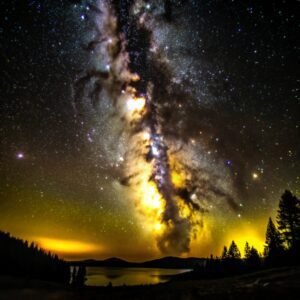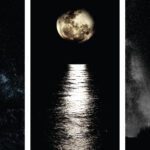
Table of Contents
Nestled in the heart of Nova Scotia, Kejimkujik National Park beckons stargazers and astronomy enthusiasts to embark on a celestial journey like no other. Designated as a Dark Sky Preserve, this pristine wilderness area offers an unparalleled opportunity to witness the wonders of the night sky in all its splendor. In this article, we delve into the enchanting realm of Kejimkujik’s Dark Sky Preserve, exploring its significance, the celestial wonders it unveils, and the unique experiences it offers to those who dare to look up.

The Magic of Dark Sky Preserves
Understanding the Designation
Dark Sky Preserves are areas recognized for their exceptional commitment to preserving the natural darkness of the night sky. This designation, awarded by the International Dark-Sky Association (IDA), signifies a dedication to minimizing light pollution and promoting the appreciation of the cosmos.
Kejimkujik’s Commitment
Kejimkujik, with its expansive woodlands, tranquil lakes, and rich biodiversity, became the first Dark Sky Preserve in Atlantic Canada in 2010. The park’s commitment to protecting its nocturnal environment aligns with the broader global effort to safeguard natural darkness for current and future generations.

A Symphony of Stars: Celestial Highlights
Stargazing Wonders
Kejimkujik’s Dark Sky Preserve unveils a celestial symphony that captivates observers throughout the year. From meteor showers and constellations to the dance of planets, each night offers a new chapter in the cosmic narrative.
Meteor Showers and Celestial Events
The park serves as a front-row seat to annual meteor showers, such as the Perseids and Geminids, where streaks of light paint the night canvas. Celestial events like lunar eclipses and planetary alignments become breathtaking spectacles against the backdrop of the park’s pristine darkness.
The Milky Way’s Radiance
One of the most awe-inspiring sights is the Milky Way stretching across the sky like a luminous river. With minimal light pollution, the Milky Way’s radiance becomes a vivid tapestry of stars, inviting viewers to contemplate the vastness of the universe.
Immersive Experiences: Stargazing Adventures
Night Sky Interpretation Programs
Kejimkujik National Park offers a range of night sky interpretation programs led by knowledgeable astronomers and park interpreters. These programs provide insights into the science of astronomy, the mythology of constellations, and the cultural significance of the night sky.
Telescopic Observations
Telescopic observations bring distant celestial objects into sharp focus. Visitors have the opportunity to peer at distant planets, distant galaxies, and celestial wonders that are often invisible to the naked eye.
Night Photography Workshops
For photography enthusiasts, the park conducts night photography workshops, guiding participants in capturing the beauty of the night sky. The absence of light pollution allows for stunning long-exposure shots that showcase the intricate details of the cosmos.

Preserving Darkness: Conservation Efforts
Light Pollution Mitigation
The Dark Sky Preserve designation underscores Kejimkujik’s commitment to mitigating light pollution. Shielded outdoor lighting, awareness programs, and collaboration with nearby communities contribute to preserving the natural darkness essential for astronomical observations.
Biodiversity and Nocturnal Wildlife
Beyond the celestial wonders, Kejimkujik’s Dark Sky Preserve is integral to the preservation of nocturnal wildlife. Many species, from owls to bats, rely on the cover of darkness for essential activities. The conservation efforts extend beyond the stars, embracing the interconnectedness of the park’s ecosystems.
Practical Tips for Night Sky Explorers
Best Times for Stargazing
The best times for stargazing at Kejimkujik are during new moon phases when the sky is darkest. Check the park’s calendar for specific astronomical events and programs.
Equipment and Attire
For an optimal experience, bring binoculars or a telescope if you have them. Dress warmly, even in warmer months, as nighttime temperatures can drop.
Conclusion: A Cosmic Symphony in the Wilderness
Kejimkujik’s Dark Sky Preserve invites visitors to step away from the glow of city lights and immerse themselves in a cosmic symphony. As one of Canada’s premier stargazing destinations, it not only unveils the marvels of the universe but also reinforces the importance of preserving natural darkness. Whether you’re a seasoned astronomer or a first-time stargazer, Kejimkujik National Park offers a celestial odyssey that transcends the ordinary and invites us to look up and wonder.
Support Us with Crypto!
If you enjoy our content and want to help keep this site running, you can support us with crypto.
Your support is appreciated!

Tron Network: USDT (TRC20)
Also read our recent blog – Voyageurs National Park: Minnesota’s Canadian Neighbor
What is a Dark Sky Preserve?

A Dark Sky Preserve is an area designated for its commitment to minimizing light pollution, allowing for optimal stargazing and the preservation of natural darkness. Kejimkujik National Park received this designation in 2010.
What makes Kejimkujik’s Dark Sky Preserve special?
Kejimkujik is the first Dark Sky Preserve in Atlantic Canada. Its expansive woodlands, tranquil lakes, and dedicated conservation efforts make it an exceptional location for stargazing and appreciating the night sky.
What celestial events can be observed in Kejimkujik?
Kejimkujik offers a range of celestial wonders, including meteor showers like the Perseids and Geminids, lunar eclipses, and vivid displays of the Milky Way. The park’s pristine darkness enhances the visibility of these events.
Are there programs or guided tours for stargazing?
Yes, Kejimkujik National Park offers night sky interpretation programs led by astronomers and park interpreters. These programs cover astronomy science, constellation mythology, and cultural aspects related to the night sky.
Can I bring my own telescope for stargazing?
Absolutely! Visitors are encouraged to bring their own telescopes or binoculars for stargazing. The park also conducts telescopic observations during certain programs.
Are there opportunities for night photography?

Yes, the park conducts night photography workshops, providing participants with guidance on capturing the beauty of the night sky. The absence of light pollution allows for stunning long-exposure shots.
What are the best times for stargazing in Kejimkujik?
The best times for stargazing are during new moon phases when the sky is darkest. Check the park’s calendar for specific astronomical events and stargazing programs.
How does the park mitigate light pollution?
Kejimkujik National Park employs measures to mitigate light pollution, including shielded outdoor lighting and awareness programs. Collaboration with nearby communities further supports these efforts.
Is stargazing possible year-round?
Yes, stargazing is possible throughout the year. Different seasons offer unique celestial events, and winter months provide particularly crisp and clear skies.
What should visitors know about respecting the night environment?
Visitors are encouraged to minimize the use of artificial light, opt for red-filtered lights when necessary, and adhere to Leave No Trace principles to respect the natural environment and wildlife.

Badhan is a passionate blogger, content writer, SEO expert, and graphic designer who helps brands grow through strategic content and creative design.